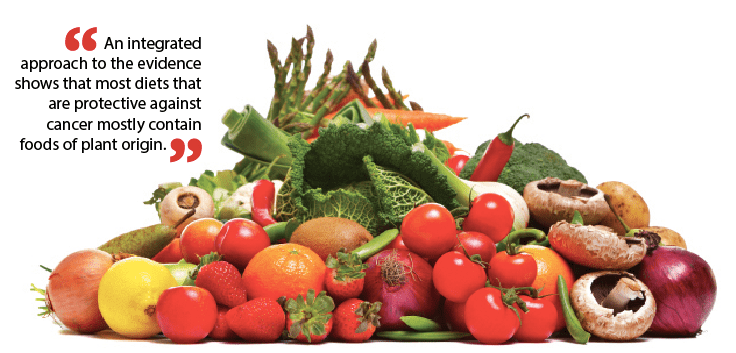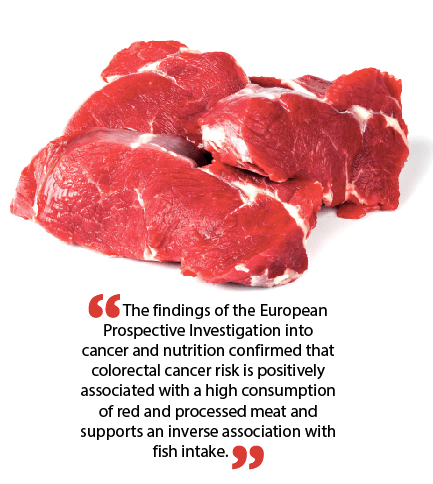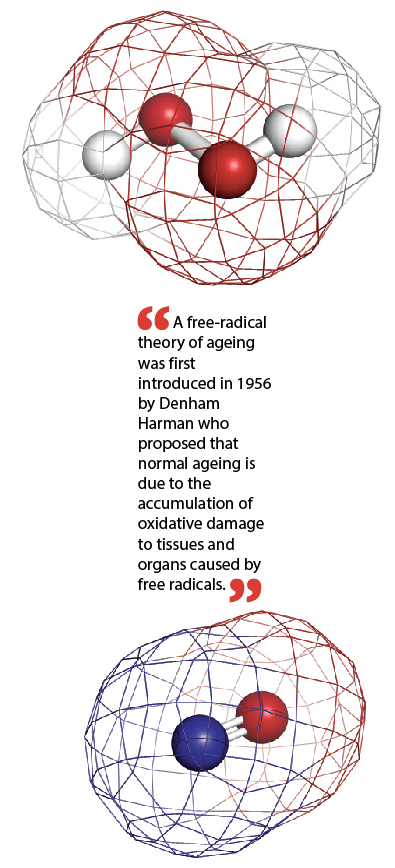Alenka Franko examines the evidence surrounding the significance of food and diet on cancer rates as well as the ageing process and its associated diseases
Our understanding of the causes of cancer and the ageing process is still quite limited1,2. It is well known that the world’s population is ageing and cancer is considered a disease associated with ageing. It has also been suggested that biological and clinical changes that accompany ageing exert a major influence on the biology and management of cancer. Results from studies have shown that older adults have a higher risk of developing cancers and also other diseases that may affect cancer treatment, care, and recovery1, 3–5.
Understanding the aetiology of cancer as well as ageing has kept researchers occupied for centuries. Many theories have been proposed to explain cancer aetiology and the ageing process1,5. According to the Rothman model of causation, exposures to different hazards, time of exposure, genetic factors, immune system, and possibly also unknown causes have a crucial role in the occurrence of diseases (e.g., cancer) and the ageing process6. It has been proposed that food is one of the important factors that may affect the risk of cancer and influence the ageing process7–13. Accordingly, scientists have estimated that ‘less healthy diets’ may increase the risk of cancer and adversely affect ageing. It has been estimated that dietary factors account for at least 30% of all cancers in western countries14,15 and up to 20% in developing countries15.
Food and cancer
Many studies have investigated the association between dietary factors and different types of cancer. The cancers that have been most extensively investigated are colorectal, stomach, oesophageal, liver, mouth, pharynx, larynx, breast, and prostate cancers7–13.
However, very few specific foods or drinks have been convincingly shown to increase or decrease the risk of cancer. The association is complex and difficult to unravel. This is due to the fact that our diet is comprised of many different types of food, and these foods consist of many different nutrients and chemicals that could affect our risk of cancer and the ageing process7.
 Food and drinks that promote weight gain
Food and drinks that promote weight gain
Evidence shows that food and diets that are high in energy, particularly those that are highly processed, and sugary drinks, increase the risk of obesity and being overweight8. It has been established that obesity can contribute in up to 20% of all cancers16, including cancers of the oesophagus (adenocarcinoma), colorectal, breast, and endometrium15,17.
In a study by Arnold et al.18, differences across age and sex in the burden of oesophageal and gastric cancers were assessed in the context of the global obesity epidemic. The findings showed that variation in obesity prevalence may partly explain age and sex differences in the incidence of oesophageal adenocarcinomas18. Fahey et al., suggested that a number of modifiable pre-diagnosis risk factors have a carryover effect on the risk of death from oesophageal cancer, including smoking, drinking alcohol, and body mass index (BMI)19,20.
Obesity is also known as one of the most closely related risk factors for colorectal cancer. Metabolic disturbances due to a high energy balance may trigger and accelerate colorectal cancer development16,17,20,21. Some epidemiological studies have clearly shown a direct association between obesity and the risk of developing colon cancer16,17,21.
Regarding breast cancer, obesity has been suggested to be an important risk factor20. In the study of Lajous et al., rapidly absorbed carbohydrates were associated with postmenopausal breast cancer risk among overweight women and women with a large waist circumference22. It has been proposed that carbohydrate intake may also be associated with oestrogen receptor-negative breast cancer22.
Additionally, obesity has also been associated with endometrial cancer20,23,24, as well as cancer of the ovary, prostate, kidneys, gall bladder, and pancreas23.
On the other hand, foods low in energy may protect against some cancers8.
Plant foods
Specific types of low energy foods, such as vegetables and fruits, and food containing dietary fibres have been proposed to protect against some cancers, such as cancer of the stomach, oesophagus, mouth, pharynx, larynx, breast, and lungs7. Food containing dietary fibres have also been suggested to protect against colorectal cancers8,9,25. The findings of the studies indicate that a high consumption of fruit and vegetables is associated with a reduced risk of colorectal cancer, especially colon cancer9,25,26. In a study by Shin et al., a high intake of total soy products or dietary isoflavones was associated with a reduced risk of overall colorectal cancer and the association may be more relevant to distal colon or rectal cancers27.
The consumption of fruit, vegetables, and food containing dietary fibres has also shown a significant protective effect against gastric cancer in some studies12,26,28, while this observation has not been clearly supported in others29,30.

A high dietary fibre intake and lower consumption of total sugars has also been associated with a lower risk of hepatocellular and intrahepatic bile duct carcinomas34.
Dietary fibre has also been suggested to play a role in the risk of breast cancer through its ability to lower circulating oestrogen concentrations via the inhibition of intestinal reabsorption of oestrogen excreted in the bile, and by an increase in their faecal excretion35,36. The findings of the study by Zhang et al., suggested that consumption of total dietary fibre and fibre from vegetables and fruits was inversely associated with breast cancer risk37. On the other hand, the study of Ferrari et al., showed that fibre from vegetables, but not from fruit or cereals, was associated with a decreased risk of breast cancer38.
Numerous observational studies have found that lung cancer patients generally report a lower intake of fruits, vegetables, and related nutrients (such as ß-carotene) than control groups39,40.
Although the intake of vitamin A from fruits and vegetables (ß-carotene) was strongly associated with a reduced lung cancer risk in some studies39–41, in controlled trials ß-carotene failed to produce any benefit when given as a supplement for up to 12 years15,42,43.
An integrated approach to the evidence shows that most diets that are protective against cancer contain mostly foods of plant origin8.
Animal foods
Many studies investigated the association between red meat consumption and the risk of developing cancer8,44. In October 2015, the International Agency for Research on Cancer (IARC) in Lyon, France, evaluated the carcinogenicity of red meat (for example beef, veal, pork, lamb, mutton, horse, or goat meat, including minced or frozen meat) and processed meat44. The working group assessed more than 800 epidemiological studies. The largest body of epidemiological data concerns colorectal cancer. Data on the association of red meat consumption with colorectal cancer were available from 14 studies and positive associations with high versus low consumption were observed in half of those studies. The findings of the European Prospective Investigation into cancer and nutrition confirmed that colorectal cancer risk is positively associated with a high consumption of red and processed meat and supports an inverse association with fish intake45. Similarly, the Swedish cohort study suggested that a high consumption of red meat may substantially increase the risk of distal colon cancer46. In the study by English et al., the consumption of fresh red meat and processed meat seemed to be associated with an increased risk of rectal cancer, while no increased risk was observed with the consu
On the contrary, milk has been proposed to protect against colorectal cancer. However, there is limited evidence suggesting that milk protects against bladder cancer. There is also limited evidence that cheese is a cause of colorectal cancer. Diets high in calcium may be a cause of prostate cancer (around 1.5 g per day or more); and there is limited evidence indicating that high consumption of milk and dairy products is a cause of prostate cancer8.
Preservation, processing and preparation of food
It has also been suggested that some methods of food preservation, processing, and preparation affects the risk of cancer. The strongest evidence concerns processed meat, preserved by salting, pickling, smoking, fermentation, addition of chemicals, and other processes to enhance flavour or improve preservation8. Most processed meats contain pork or beef, but might also contain other red meats, poultry, offal (e.g., liver), or meat by-products such as blood44.
In a recent IARC evaluation of carcinogenicity, a positive association was found between colorectal cancer and the consumption of processed meat in 12 out of 18 cohort studies, including studies in Europe, Japan, and the USA44,45,48–51. A meta-analysis of colorectal cancer in 10 cohort studies reported a statistically significant dose-response relationship, with an 18% increased risk per 50 g per day of processed meat44. Based on the large amount of data and the consistent associations of colorectal cancer with the consumption of processed meat across studies in different populations, the majority of the IARC working group concluded that there is sufficient evidence in human beings for the carcinogenicity of the consumption of processed meat. Overall, the IARC working group classified the consumption of processed meat as ‘carcinogenic for humans’ (Group 1)44.
Pesticides
It has also been proposed that pesticides could increase the risk of leukaemia, lymphoma, brain tumours, breast cancer or prostate cancer, yet for now, evidence is not strong enough to show a definite link8. According to the IARC, pyrethroids (deltamethrin, permethrin and fenvalerate) were not classifiable as to its carcinogenicity to humans (Group 3)52–54. On the other hand, the IARC classified glyphosate as possibly carcinogenic to humans (Group 2A)55.
Alcohol
The evidence that all types of alcoholic drinks are a cause of a number of cancers is strong8,15,56.
Numerous studies have proved that alcoholic drinks are a cause of cancer of the mouth, pharynx, larynx, oesophagus, and breast (pre- and postmenopausal)8,15,56. The results of the studies also suggest that alcohol and tobacco together increase the risk of these cancers more than either acting independently8,15,57.
Regarding oesophageal cancer, the association between alcoholic drinks and this cancer is convincing8,57,58.
Many cohort and case control studies have investigated the influence of alcoholic drinks on breast cancer. The evidence that alcoholic drinks are a cause of premenopausal and postmenopausal breast cancer is convincing8,56–59. There is generally consistent evidence from case control studies and a dose-response relationship is apparent8,56–59. The studies have shown that low-to-moderate alcohol intake has been associated with the risk of oestrogen receptor-positive breast cancer with the strongest association in postmenopausal women. Since alcohol intake is a modifiable risk factor of breast cancer, every woman should be informed and advised to control their alcohol consumption8,56. The results of the recent study by Xu et al., also suggests that chronic ethanol exposure can enhance the aggressiveness of breast cancer by activating the p38 MAPK/RhoC pathway59.
Food and ageing
Our knowledge of how dietary patterns change with age and how food affects ageing is limited. Most dietary data are cross-sectional — people in one age group are compared with different people in another group. However, these studies do not permit the effects due to age to be distinguished from those of a given cohort60. Nevertheless, it has been suggested that optimal nutrition is essential for successful and healthy ageing, especially as advancing age increases the risk of chronic diseases and other health concerns60–62.
Calorie restriction
Different studies have investigated that what we eat, how frequently, and how much, may affect quality and years of life60–62. Calorie restriction has been of particular interest. The results of some studies performed in animals have shown that calorie restriction of up to 40% fewer calories than normal has an impressive positive effect on disease, markers of ageing, and, perhaps, life span. However, even though calorie restriction appears to work in a variety of species, such as yeast, fruit flies, some strains of mice, rats, as well as other species, several animal models, including wild mice, show no lifespan extension by calorie restriction. In some strains of mice, calorie restriction even appears to shorten lifespan. Furthermore, studies in non-human primates also have non-consistent results62.
Calorie restriction studies on humans are still on-going. However, it is not known yet if a long-term calorie restriction is safe, beneficial, or practical for humans62. Reduced energy intake may lead to inadequate levels of protein, vitamins, and minerals60. Due to a declining metabolic efficiency and bioavailability, requirements for some micronutrients might actually be higher for older adults than for younger people60.
Plant foods
Dietary fibres
The dietary fibre intake of older adults is shown to be lower than recommended levels63. To meet carbohydrate recommendations as well as limit discretionary energy intake, older adults should choose a variety of fibre rich fruits, vegetables, and whole grains. In addition to providing nutrients such as vitamins and minerals, fibre provides benefits, such as improved gastric motility, improved glycaemic control, and reduced cholesterol61.
Fruits and vegetables
The protective effect of fruits and vegetables in the prevention of chronic and degenerative diseases has been extensively investigated61. A higher consumption of fruits and vegetables is considered to be a marker for an overall healthier diet and also healthy ageing61.
In the longitudinal cohort study of Miedema et al., a higher intake of fruits and vegetables during young adulthood was associated with lower odds of prevalent coronary artery calcium after 20 years of follow-up. The results of this study reinforce the importance of establishing a high intake of fruits and vegetables as part of a healthy dietary pattern early in life64.
Microelements
Vitamin D and calcium
Adequate vitamin D and calcium are best known for their crucial role in the prevention and delay of the progression of osteoporosis. The role of vitamin D and calcium in other health outcomes such as cancer, diabetes, heart disease, and immunity, has also received much attention61. Evidence supports the role of vitamin D and calcium in bone health but not other health conditions. Furthermore, some research indicates that too many of these nutrients may be harmful61,65. On the other hand, low levels of vitamin D was found to be associated with cognitive decline66.
Vitamin B12 and folic acid
It has been estimated that 6 to 15% of older adults have vitamin B12 deficiency and approximately 20% have a marginal status as a result of malabsorption, lack of intrinsic factor, atrophic gastritis, and, in some cases, poor diet. A well-known complication of vitamin B12 deficiency is macrocytic anaemia and also neurological complications, affecting both sensory and motor function, osteopenia, neurocognitive impairment and increased vascular disease risk61,67.
In regards to folic acid, cereal grain products and ready-to-eat cereals can contribute significant amounts of folic acid to diets. When the intake of folic acid-fortified foods is combined with supplements containing folic acid, excessive levels may be consumed. Folic acid intake in excess may mask the diagnosis of vitamin B12 deficiency. It is suggested that at even subclinical levels of deficiency, older adults may have changes in their mental status, which may be overlooked and attributed to normal ageing61,67. An experimental ageing model using Caenorhabditis elegans (roundworms), showed for the first time that folic acid could extend organism lifespan and cause a delay in ageing68.
On the other hand, in a randomized placebo-controlled trial, including participants aged ≥65 years, two-year supplementation of vitamin B12 and folic acid was neither effective in reducing the age-related decline in physical performance and hand-grip strength, nor in the prevention of falling in elderly persons. It has been concluded that these effects should be further tested in future studies69.
Proteins
Sufficient high quality dietary protein intake is required to prevent or treat sarcopenia in advancing age. Sarcopenia is the age-related loss of skeletal muscle mass and strength, accompanied by a decline in function ability that affects many aspects of life70,71. It is well known that dietary protein ingestion stimulates skeletal muscle protein synthesis and inhibits protein breakdown72–74, resulting in protein balance73 and muscle mass gain71. Although the role of dietary protein in the prevention of sarcopenia remains unclear75, a protein intake moderately greater than the usual amount may be beneficial to enhance muscle protein anabolism and reduce progressive muscle mass loss with age76. Some experts propose that protein intake of 1.0 to 1.6 g/kg daily is safe and adequate to meet the needs of healthy older adults77. Despite the possibility of increased protein needs, data suggest that dietary protein intake declines with advancing age78. Nevertheless, it is known, that although potential differences in the efficiency of protein utilization may exist, ageing does not impair the ability to synthesize muscle protein after consumption of a high quality protein meal and resistance exercise79. Evidence suggests that in both young and old adults the upper limit on how much protein can be used at a single meal is approximately 30 g80. Therefore, it has been suggested by some experts that 25 to 30 g of high quality protein per meal is required to allow an appropriate stimulation of postprandial muscle protein synthesis61,71,76.
Antioxidants, cancer and ageing
The findings of recent studies indicate that reactive oxygen species (ROS) and reactive nitric species (RNS) play a key role in developing cancer and ageing2,81–83.
A free-radical theory of ageing was first introduced in 1956 by Denham Harman who proposed that normal ageing is due to the accumulation of oxidative damage to tissues and organs caused by free radicals84. This theory explains not only the mechanism of ageing, but also a wide variety of age-associated pathologies, including cancer1,81. A free radical is an atom or molecule that contains an unpaired electron in its outer orbital. This situation confers them instability and the need to lose/gain an electron in order to become stable82.
The ROS and RNS are harmful as they are known to damage all types of biomolecules, including deoxyribonucleic acid (DNA), proteins, and lipids85,86. Complex defence mechanisms, including enzymes, proteins, and antioxidants are involved in the prevention of cell damage85,86. However, antioxidant defences do not protect completely against ROS and RNS and levels of damage to DNA, lipids, and proteins can be detected in organisms2,82.
In addition to enzymes, many dietary antioxidants including vitamin A, vitamin C, vitamin E, beta-carotene, ascorbic acid, α-tocopherol, coenzyme Q10, plant flavonoids, and many others have been suggested to scavenge ROS in cells and therefore theoretically extend lifespan2. Some studies showed that people with a low intake of antioxidant-rich fruits and vegetables were at greater risk for developing chronic conditions, including cancer. Therefore, it has been proposed that antioxidant supplement could serve as a protection against heart disease, cancer, and other diseases. The results of the studies have been mixed, but many of them have not found the hoped-for benefits81,87,88.
Research in humans has not demonstrated convincingly that taking antioxidant supplements can help reduce the risk of developing and dying from cancer or heart disease, and some studies have even shown an increased risk of some cancers87. For instance, the Carotene and Retinol Efficacy Trial presented an increased risk of lung cancer and increased death from all causes in subjects with history of smoking or asbestos exposure who received daily supplementation with both 15 mg beta-carotene and 25,000 International Units (UI) retinol3. Similarly, the Carotene Prevention study investigated whether the use of alpha-tocopherol and/or beta-carotene supplement for 5 to 8 years could help to reduce the incidence of lung and other cancers in middle-aged male smokers in Finland. Initial results showed an increase in the incidence of lung cancer among participants who took beta-carotene supplements (20 mg per day). On the contrary, alpha-tocopherol supplementation (50 mg per day) had no effect on lung cancer89. Later findings showed no effect of beta-carotene or alpha-tocopherol supplementation on the incidence of bladder, ureter, renal, pancreatic, colorectal, oral, pharyngeal, oesophageal, or laryngeal cancers90–93.
Collagen supplements
Collagen is a family of fibrous protein, which is found mostly in fibrous tissues such as the skin, tendons, and ligaments. It is also abundant in corneas, cartilage, bones, blood vessels, the intervertebral discs, the dentin in teeth and the gut. As these tissues undergo natural chronological ageing, dietary collagen supplements could help restore collagen levels94, 95.
The benefits of collagen supplements may include improved skin texture and firmness, reduction of wrinkles, reduction in the appearance of cellulite, improved quality and strength of new hair, improved circulation, tendon and joint flexibility and strength, reduced joint pain, and also improved recovery from sports injuries and muscle repair94, 95.
However, we also have to be aware of possible side effects, such as a bad taste in the mouth, decreased appetite (which may be a benefit in some cases) and high calcium levels. Collagen supplements that come from shell fish and shark cartilage contain high amounts of calcium, which can raise the calcium levels of subjects. Too much calcium in the body can cause nausea, vomiting, constipation, fatigue and abnormal heart rhythms. Taking collagen supplements can also result in allergic reaction in individuals allergic to collagen sources (fish, shellfish, bovine, porcine, chicken)94, 95. Nevertheless, the possible side effects and benefits of collagen supplements should be further investigated.
Conclusions
Although the association between different foods and cancer, as well as between various foods and ageing has been extensively investigated, the findings are often not consistent. To better understand and elucidate the influence of dietary factors on both cancer and ageing, further research is needed. Nevertheless, based on the findings of the studies conducted so far, the consumption of low energy foods, such as fruits, vegetables, and foods containing dietary fibres, is recommended for healthier ageing and also to reduce the risk of developing cancer. On the other hand, the consumption of processed meat and other processed, preserved, and prepared food, red meat as well as alcohol is advised to be restricted. It has been proposed that protein intake of 1.0 to 1.6 g/kg daily is safe and adequate to meet the needs of healthy older adults.
It is also important to know that current evidence does not confirm that antioxidant supplementation is recommended as a useful means of preventing cancer and age-related pathophysiological modification and clinical conditions. Until more scientific evidence about the benefits or harm of taking antioxidant supplementation is provided, these supplements should be used with caution. With respect to nutrition, cancer and age, public health policy should be based on the best available scientific research findings.







